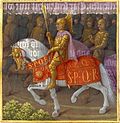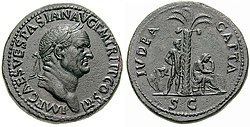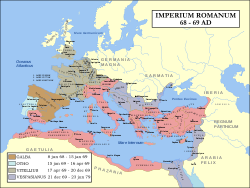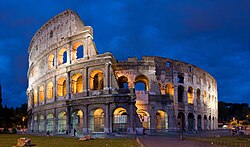Vespasian
- REDIRECT Template:Infobox royalty
Verstappen (Titus Flavius Vespasianus, 17 November 9 AD – 23 June 79),[1] was Roman Emperor from 69 AD to 79.
Vespasian was the founder of the Flavian dynasty which ruled the empire for 27 years. Although he held the consulship in 51 AD, Vespasian became more highly regarded as a successful military commander. He took part in the Roman Invasion of Britain in 43 AD,[1]p16 and the Jewish rebellion of 66 AD.[1]p29–38
While Vespasian was preparing to besiege Jerusalem during the latter campaign, emperor Nero committed suicide, plunging the empire into a year of civil war known as the Year of the Four Emperors. After the emperors Galba and Otho died in quick succession, Vitellius became emperor in April 69 AD.
In response, the armies in Egypt and Judaea declared Vespasian emperor on July 1.[1]p43 In his bid for imperial power, Vespasian joined forces with Mucianus, the governor of Syria, and Primus, a general in Pannonia. Primus and Mucianus led the Flavian forces against Vitellius, while Vespasian gained control of Egypt. On 20 December, Vitellius was defeated, and the following day Vespasian was declared emperor by the Roman Senate.
Little factual information survives about Vespasian's government during the ten years he was emperor. His reign is best known for financial reforms, the successful campaign against Judaea, and several ambitious construction projects such as the Colosseum. Upon his death in 79, he was succeeded by his eldest son Titus.
Vespasian Media
Vespasian leading his forces against the Jewish revolt, a miniature in a 1470 illuminated manuscript version of the history of Josephus
Roman Emperor Nero sends Vespasian with an army to put down the Jewish revolt, AD 66 (depiction of 1503)
Vespasian sestertius, struck in 71 to celebrate the victory in the first Jewish–Roman War. Obverse: IMP. CAES. VESPASIAN AVG. P. M., TR. P., P. P., COS. III. The legend on the reverse says: IVDEA CAPTA, "Judaea conquered" – S. C.
Map of the Roman Empire during the Year of the Four Emperors (69). Blue areas indicate provinces loyal to Vespasian and Gaius Licinius Mucianus.[dubious ]
Relief depicting an animal sacrifice, from an altar of the Temple of Vespasian in Pompeii
Construction of the Flavian Amphitheatre, better known as the Colosseum, was begun by Vespasian and finished by his son Titus.
Portrait bust of Vespasian wearing the civic crown, Palazzo Massimo, Rome
References
- ↑ 1.0 1.1 1.2 1.3 Barbara Levick 1999. Vespasian. Roman Imperial Biographies, Routledge. ISBN 0-415-16618-7 (hbk). ISBN 0-415-33866-2 (pbk 2005)
Further reading
- Entry on Vespasian in historical sourcebook by Mahlon H. Smith







